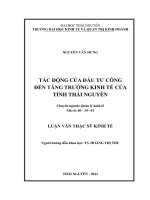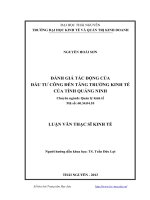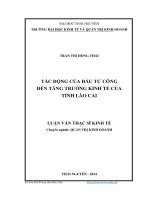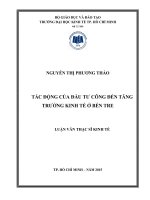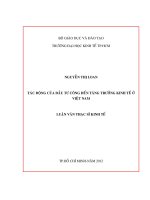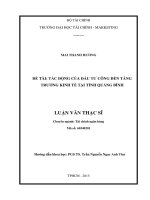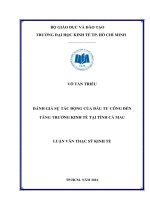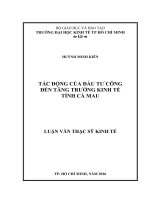Tác động của đầu tư công đến tăng trưởng kinh tế và lạm phát tại việt nam TT TIENG ANH
Bạn đang xem bản rút gọn của tài liệu. Xem và tải ngay bản đầy đủ của tài liệu tại đây (448.01 KB, 26 trang )
MINISTRY OF EDUCATION AND TRAINING
STATE BANK OF VIETNAM
BANKING ACADEMY OF VIETNAM
---------
NGUYEN THI KIM CHUNG
THE IMPACT OF PUBLIC INVESTMENT ON ECONOMIC
GROWTH AND INFLATION IN VIETNAM
SUMMARY OF DOCTORAL THESIS
Hanoi - 2021
MINISTRY OF EDUCATION AND TRAINING
STATE BANK OF VIETNAM
BANKING ACADEMY OF VIETNAM
NGUYEN THI KIM CHUNG
THE IMPACT OF PUBLIC INVESTMENT ON ECONOMIC
GROWTH AND INFLATION IN VIETNAM
MAJOR: FINANCE - BANKING
CODE : 9340201
SUMMARY OF DOCTORAL THESIS
INSTRUCTOR IN SCIENCE: 1.ASSOC.PROF.DR.DAO MINH PHUC
2. ASSOC.PROF.DR.LE THI TUAN NGHIA
Hanoi - 2021
1
PREFACE
1. Necessity of research topic
According to the World Bank, "public investment is public expenditure that increases
the accumulation of physical capital. Total public investment includes investments in
physical infrastructure by central government, local government and public sector
companies". At the same time, OECD believes that the definition and measurement of
public investment vary from country to country, but generally refers to investment in
physical infrastructure (roads, government buildings, etc.). And soft infrastructure (e.g.,
support for innovation, research and development, etc.) has a service life of more than one
year. Public investment has always been regarded as one of the government's fiscal
instruments, with the main goal of stimulating long-term economic growth and influencing
the economic system to maximize economic welfare (Tanzi & Zee, 1997).
It can be said that public investment is one of the important policies for the social and
economic development of the whole country, especially for developing countries.
Government expenditure will consist of two parts: expenditure for the government's own
needs (and the performance of government functions), and expenditure for the measures
taken by the government. Intervene in the market. Among these expenditures, public
investment has dual effects: on the one hand, it is consumption itself, which directly
increases the total demand of society. On the other hand, it stimulates private investment
through the spillover effect of increased demand, which will stimulate entrepreneurs'
investment confidence, optimism and enthusiasm. Through this dual effect, public
investment will promote economic growth and development. Public investment has a direct
and indirect impact on the total supply and demand in the economy through its influence on
other factors in the economy. From the perspective of Keynesianism, the influence of public
investment on demand-side economic growth. Keynes believed that the market will never
work perfectly, so government intervention is needed to increase effective demand,
stimulate consumption and production, and stimulate investment to ensure employment and
increase income.
Vietnam's economic reform began at the Sixth National Congress in 1986. Over the
past 35 years, Vietnam has made great strides to become one of the most developed
economies in Asia. The economy is expanding day by day, and the GDP in 2019 is 12.5
times that in 2001. The GDP growth rate is relatively high, with an average annual growth
2
rate of 7.26% from 2001 to 2010, reaching the growth rate of 7.56%/year of the social and
economic stability and development strategy in 1991-2000, which is a very important
economic development achievement in this period of China. During the period from 2011 to
2019, GDP increased by 6.3%/year, including 7.08% in 2018, which is the highest growth
rate since 2008. GDP will increase by 2.4 times, from US $116 billion in 2010 to US $268.4
billion in 2020. GDP per head will rise from $1,331 in 2010 to about $2,750 in 2020. The
above results in Vietnam are mainly the contribution of public investment process. But in
addition to the success of economic development, keeping inflation at a safe level has
always been a top concern for the Vietnamese government. In 1999 and the first two years
of the 21st century, the inflation rate in China was very low. In fact, in 1999, 2000 and
2001, the CPI growth rate was very low, only single digit. Even during deflation in 2000,
the inflation rate was-0. 6%. In 2002 and 2003, the inflation rate rose again, but not too
high. In 2002, the inflation rate was 4%, and in 2003 it was 3%. However, from 2004 to
2009, the inflation rate in Vietnam remained at a relatively high level, at 10%. During the
first three years of this period, the inflation rate increased significantly over the previous
period, although it remained in the single digits, i.e. 9.5 percent in 2004 (an increase of
216.7 percent). Compared with 2003), it was 8.4% in 2005 and 6.6% in 2006. However, in
the face of this situation, there is no satisfactory solution in China. Therefore, in 2007 and
2008, China's inflation rate rose and fell into an uncontrollable situation, and the consumer
price index (CPI) soared to double digits. Specifically, the inflation rate reached doubledigit thresholds of 12.36 percent in 2007 and 24.4 percent in 2008. The reason is that with
the world economic recession, the depreciation of the US dollar, the rise of crude oil prices,
the sudden rise of food and raw material prices, and the impact of natural disasters and
epidemics. Vietnam's economy exposes the inherent weaknesses of the transition economy.
Since then, thanks to the timely efforts of economic policies, including public investment
policies, the government has stabilized the inflation rate, which reached 7% in 2009. During
the period from 2010 to 2019, it benefited from the simultaneous implementation of
monetary policy, including strict control of public and financial investment policies,
promotion of production development, increase of exports and inflation. The development is
stable at the single digit level and tends to decline.
Public investment in Vietnam serves both as a guide and as an attraction to other
sources of capital, contributing to investment, construction of technological facilities in the
3
productive and commercial sectors and development areas. Carry out social activities to
enhance the potential of the country's economic zone to develop together for the country's
socio-economic development goals. Public investment plan has achieved the goal of social
and economic development, and is an important object of national economic plan to curb
inflation. However, if public investment is not well controlled, it will have serious
consequences for economic development and push up the inflation rate. In view of this
function and significance, the author chooses “The Impact of Public Investment on
Economic Growth and Inflation in Vietnam” as the theme of the thesis. For research
purposes, at the same time, we have a deep understanding of the public investment situation
in Vietnam in the past 25 years (1995-2019), as well as the impact of public investment on
economic growth and Vietnam. The impact of public investment on domestic inflation.
There is no research on these two aspects at the same time in China. In addition, more
research has been conducted on the experiences and lessons learned in the use and
management of public investment capital in some countries in the Asia-Pacific region. From
there, propose appropriate solutions to help effective public investment while stimulating
effective and sustainable economic growth in the new era.
2. Research objectives
General objective: To analyze the impact of public investment on economic
growth and inflation in Vietnam. From there, solutions are proposed to improve the
efficiency of public investment expenditure and achieve economic growth and control goals
in the future.
Specific objectives:
- To analyse and assess the experience of typical countries with regard to the impact
of public investment on economic growth and inflation and to draw lessons from the
experience of Vietnam. This thesis analyzed and evaluated the public investment policies of
these countries. Through the achievements in economic growth and inflation control, this
thesis pointed out the limitations and shortcomings of policies, and the main factors that
lead to the failure or success of investment budget, waste or effective use.
- A theoretical summary of the impact of public investment on economic growth
and inflation
- Assess the current situation of public investment in Vietnam from 1995 – 2019.
- To analyse and assess the impact of public investment on economic growth in
4
Vietnam and the impact of public investment on inflation.
- Propose public investment policies and solutions to promote economic growth and
well control inflation in Vietnam for some time to come.
3. Research question
- What is the reality of public investment in Vietnam in the period 1995 -2019?
- How does public investment affect economic growth and inflation in Vietnam in
the period 1995 - 2019?
- What solutions are needed to promote Vietnam's economic growth and well
control inflation in the coming time?
4. Subject and scope of research
- Analytical period: From 1995 - 2019.
- Analytical space: Macroeconomic context of Vietnam.
- Research object: Impact of public investment on economic growth; impact of
public investment on inflation in Vietnam.
- Research scope: The main research content is the one-way impact of public
investment on economic growth and inflation in Vietnam.
5. Research Methods
Research Methods
To realize the research objectives, the thesis applies a combination of both qualitative
and quantitative research methods. In which:
- Qualitative research: Using inherited methods, synthetic methods, descriptive
statistics of average values, percentages, growth rates for analysis and comparison, to assess
the current state of public investment, increase economic growth and inflation in Vietnam;
assess the successes and limitations in public investment in the period 1995-2019.
- Quantitative research: Applying the vector autoregression (VAR) model by Sims
(1980) to describe the impact of public investment on economic growth and public
investment on inflation. Through important analysis tools of VAR model such as Granger
causality test, shock analysis and analysis of variance decomposition.
Research data
- Data to assess the state of public investment, economic growth and inflation in
Vietnam are used from 1995-2019. Secondary data on public investment capital; Non-state
investment capital; investment capital with capital sources from abroad; world oil prices;
5
money supply is collected from various sources including General Statistics Office, World
Bank data, Asia Pacific Development Bank data.
- The data used in the VAR model is quarterly time series data, in the period from
1995-2019.
Research Procedure
In order for the thesis to be researched effectively, the thesis has been carried out
through the following steps according to the research procedure shown in Figure 1 below:
Determine the problems and research objectives of the thesis
Establish the theoretical basis of the thesis
Establish the Research model
Data acquisition and processing
Check data
Realization of regression model
Carry out proper inspection
Introduce and explain the research results
Propose solutions and policies
Figure 1: The thesis implementation procedure
6. Overview of the research
6.1. A summary of the impact of public investment on economic growth
6.2. A summary of the research on the impact of public investment on inflation
In a word, there are many different methods to evaluate the impact of investment and
public investment on economic growth and inflation, namely: Guble-Dusla cost function
method; Linear regression approach; Autoregressive vector method (VAR), vector error
correction model (VECM), ARDL regression. These are the alternative methods applied to
this study.
6
7. Scientific contribution of the thesis
- Theoretically: This thesis combined qualitative research with quantitative
research, and studied the impact of public investment on economic growth and the impact of
public investment on domestic inflation.
- Practically: analysed and pointed out the status quo of public investment,
economic growth and inflation since Vietnam began normalizing relations with the United
States in 1995. This is a historic milestone, affirming that Vietnam has lifted the isolated
siege and really opened the door to international integration. From then until 2019, the
expansion of diplomatic relations promoted trade and investment, promoted international
cooperation in various fields, and significantly improved economic conditions and rural
society.
- Although the study still used the VAR model to estimate the impact and assess the
response of economic growth and inflation to public investment shocks. However, the thesis
also considered the influence of public investment and other factors (such as private
investment, foreign investment, international oil prices, domestic expansionary money
supply). These variables are included in the research model as control variables.
8. Structure of the thesis
The structure of the thesis consists of the following parts:
Introduction: Briefly state the reason for carrying out the thesis; Objectives of the
study; Object and scope of the study; the methods applied in the research to achieve the
objectives set by the topic; overview of previous research papers related to the research
problem of the thesis.
Chapter 1: Theoretical basis for the impact of public investment on economic
growth and inflation. This chapter mainly presents concepts and theories related to public
investment, economic growth, and inflation.
Chapter 2: The reality of the impact of public investment on economic growth
and inflation in Vietnam in the period 1995-2019. This chapter presents the assessment
results of the current state of public investment; the impact of public investment on
economic growth and inflation. Evaluation of the efficiency of using public investment
capital of Vietnam in the period 1995-2019.
Chapter 3: Testing the impact of public investment on economic growth and
inflation through the Var model. Reasons for choosing the research model; data
7
description; Research results on the impact of public investment on economic growth and
Research results on the impact of public investment on inflation through the VAR model.
Chapter 4: Recommendations on some policies to promote economic growth and
control inflation. Put forward policies and solutions to improve the efficiency of public
investment in the future to ensure sustainable economic growth and well control of inflation.
Conclusion: The main purpose is to summarize the highlights and limitations of the
research results. At the same time, some new research directions are proposed.
8
CHAPTER 1
THEORETICAL BASIS FOR THE IMPACT OF PUBLIC INVESTMENT ON
ECONOMIC GROWTH AND INFLATION
1.1. General theoretical basis of public investment, economic growth and inflation
1.1.1. Public investment
1.1.1.1. Concept
The concept of public investment used in the thesis: Through the investigation of
different concepts of public investment, the concept of public investment should be
understood as follows: the investment activities carried out by the state from the state
budget are for the sake of social and economic development, and the state or the state from
the budget can or cannot recover capital directly.
1.1.1.2. Characteristics of public investment
1.1.1.3. The role of public investment
In short, by reviewing the concept of public investment studied at home and abroad,
or according to the provisions of Vietnam Public Investment Law, it can be summarized as
follows:
Public investment is the government's budget expenditure on public services for
social and economic development and ensuring national security. Public expenditure is
mainly concentrated in areas such as capital construction investment, such as basic
infrastructure (roads, docks, electricity, schools, hospitals, etc.); Development investment
expenditure for education, health care and health care, expenditure for security and national
defense, …. Public investment capital comes mainly from the state budget, in addition to
being raised from loans, state-owned enterprise capital and other capital. Public investment
capital is decentralized by Central or local levels, and the decentralization rate depends on
the regulations of each period and the economic development direction of each period.
1.1.2. Economic growth
1.1.2.1. Concept
1.1.2.2. Determinants of economic growth
1.1.2.3. Indicators for measuring economic growth
1.1.3. Inflation
1.1.3.1. Concept
9
1.1.3.2. Assessing Indicators and Inflation Levels
1.1.3.3. Causes of inflation
1.2. The Impact of Public Investment on Economic Growth
1.2.1. Form of influence
Work investment affects economic growth through the following investment capital
factors:
(1) Public investment capital from the SB (State budget)
(2) Domestic and foreign loans
(3) Investment funds come from state-owned enterprises
1.2.2. Impact mechanism
Complementary effect of public investment and private investment
The impact of stimulating or encroaching on private investment
Increase in aggregate demand
Increase in national savings
Other effects
Table 1. 1: Summary of the Impact of Public Investment on Economic Growth
Impact channels
Impact on growth
Private investment supplement
+
Stimulate private investment
+
Embezzlement of private investment
-
Increase in aggregate demand
+
Promote
market
integration
and
+
expansion
Increase in national savings
+
Inflation has intensified
-
The trade balance deficit has increased
-
Source: State-level project code KX.01.07/11-15 “Restructuring public
investment in the framework of reforming Vietnam's growth model”
1.3. The impact of public investment on inflation
When the government increases investment and public spending to grow the economy,
10
aggregate demand will increase. The persistently high level of public spending leads to an
increase in the price level, which causes inflation. First, the state budget deficit increases
gradually over time due to the continuous increase in high public spending. Increasing state
budget spending to stimulate consumption demand, stimulate investment and increase
development investment will lead to high growth. At the same time, if spending is increased
beyond the allowable limit of the economy, it will lead to an excessively high state budget
deficit. When the budget deficit can be compensated by issuing money or borrowing, there
is a risk of inflation.
1.4. The thesis's model of testing the impact of public investment on economic growth
and inflation
1.4.1. A brief overview of the theoretical basis of the vector autoregression (VAR) model
The simple Var model has the following form:
Yt = C + q1Yt-1 + q2Yt-2 +…+ qpYt-p+ et
In which:
p is the lag of the variables in the model
Yt … Yt-p is the vector of variables in the equation Y= (Yt-1, Yt-2,…, Yt-p)
C is the vector of constants
et is the vector of errors
1.4.2. Model to assess the impact of public investment on economic growth
LNGDP =α0 + α 1 LNIG+ α 2LNIP+ α 3LNIF + α 4LNLAB + εt
(Model 1)
In which:
- LNGDP: Natural Logarithm of Gross National Product
- LnIG: Natural Logarithm of Public Investment Capital
- LnIP: Natural Logarithm of Non-State Investment Capital
- LnIF: Natural Logarithm of Foreign Direct Investment Capital Area
- LnLAB: Natural Logarithm of Labor working in the economy
1.4.3. Model to assess the impact of public investment on inflation
LnINF =β0 + β1 LnIG+ β2LnIP+ β3OIL+ β4LnLCU +ut
(Model 2)
In which:
- LnINF: Natural logarithm of the inflation rate
- LnIG: Natural Logarithm of Public Investment Capital
- LnIP: Natural Logarithm of Non-State Investment Capital
- LNOILP: International oil price
- LnLCU: Natural Logarithm of Domestic Expanded Money Supply
11
1.5. International experience and lessons for Vietnam
1.5.1. Experience from Singapore
1.5.1.1. Development of Public Investment in Singapore
1.5.1.2. Singapore's Economic Growth and Inflation in 2006-2018
1.5.1.3. The Impact of Public Investment on Singapore's Economic Growth and Inflation
1.5.2. Experience from Japan
1.5.2.1. Development of Public Investment in Japan
1.5.2.2. Japan's economic growth and inflation in 2006 – 2018
1.5.2.3. Impact of public investment on Japan's economic growth and inflation
1.5.3. Experience from Korea
1.5.3.1. Development of Public Investment in Korea
1.5.3.2. Korea's economic growth and inflation in 2006-2018
1.5.3.3. Impact of public investment on Korea’s economic growth and inflation
1.5.4. Lessons learned for Vietnam
Through the analysis and evaluation of public investment of Japan, Singapore and
South Korea, some lessons have been drawn for Vietnam in the management and effective
use of public investment as follows:
a) Strengthening investment capital for infrastructure, education, training and
scientific research
b) Strengthening public administration reform and public governance
c) Privatization of the public investment sector
d) Transparency in the management of public investments
e) Attention to decentralization of supervision and management of community public
investment
SUMMARY OF CHAPTER 1
In the chapter 1, the paper focuses on the theoretical basis related to economic growth,
public investment and inflation. And the theory of the influence of public investment on
economic growth and inflation. International experience and public investment.
From there, two proposed research models were developed to assess (1) the impact of
public investment on inflation and economic growth and other controlling variables: (2)
non-state investment, (3) investment in the FDI sector, (4) labour in the economy, (5)
international oil prices and (6) money supply.
12
CHAPTER 2
THE REALITY OF THE IMPACT OF PUBLIC INVESTMENT ON ECONOMIC
GROWTH AND INFLATION IN VIETNAM IN THE PERIOD 1995-2019
2.1. Real situation of public investment, economic growth and inflation in Vietnam
from 1995 – 2019
2.1.1. Real situation of public investment in Vietnam from 1995 - 2019
2.1.1.1. Scale of public investment
Vietnam is pursuing an economic growth model based mainly on increasing
investment capital. Therefore, during the period from 1995 to 2019, the total value of social
investment capital increased from 72.4 trillion VND in 1995 to 2,046.8 trillion VND in 2019,
an increase of 28.25 times and an average growth rate. Is 11.45%/year (constant price in
2010). Since 2011, the growth rate tends to slow down. The average growth rate during 20062010 was 13.2%/year, but in 2011-2019, this figure was only 8.7%.
2.1.1.2. Sources of public investment capital
Vietnam's investment capital mainly comes from three sources: state budget capital,
loan capital and state-owned enterprise capital. Between 1995 and 2019, public investment
capital increased from 3,044.7 billion VND in 1995 to 63,494.8 billion VND in 2019 (an
increase of 20.85 times).
2.1.1.3. Allocation and use of public investment capital
(1) Public investment by management levels
(2) Public investment by economic sectors and lines
2.1.2. Real situation of Vietnam's economic growth from 1995 – 2019
2.1.3. Real situation of Vietnam's inflation in 1995 - 2019
2.2. Impact of public investment on economic growth during 1995-2019
2.3. The impact of public investment on inflation during 1995-2019
2.4. Overall assessment of the impact of public investment on economic growth and
inflation in Vietnam from 1995-2019
2.4.1. Results achieved
First, public investment contributes to economic growth
Second, public investment is coordinated with other economic sectors
Third, public investment contributes to the development of infrastructure systems
2.4.2. Limitations
13
Besides the success of public investment in economic growth and inflation, there are
many limitations and deficiencies as follows:
In some periods (such as 1995-2019), the impact of public investment on inflation or
growth is unclear, and the inflation rate in Vietnam fluctuates greatly.
Planning has not really been effective in the implementation of investment activities,
and coordination among agencies in the formulation of socio-economic master plans, sectoral
and sectoral plans remains weak. The basis for formulating the medium-term public
investment plan and the annual public investment plan has not yet appealed for and attracted
investment from economic organizations according to the actual economic development of
Vietnam. People have not been deployed synchronously.
The investment capital structure is mainly concentrated in the infrastructure sector and
rarely in sectors directly serving human development (e.g. education, health). The efficiency
of public investment is generally limited, lower than that of the private sector and far lower
than that of the economies of the corresponding development period in East Asia.
The decentralization process of public investment capital lacks uniformity in
ensuring consistency between the powers and tasks of decentralization and the capacity to
exercise those powers and the responsibilities of the decentralized institutions. The process
of investment project management is decentralized, but it also includes many complicated
and tedious stages and procedures. This is also the reason for the slow expenditure of
investment capital.
Although the state has been paying attention to the structural adjustment of public
investment rate, the actual implementation is still very slow. The economic crisis occurred
during 2007–2009, but it was not until 2011 that the government formulated policies to
reform the economic growth model and restructure public investment. The restructuring of
public investment capital is still very slow, and the main source of public investment capital is
still the capital collected from the budget and loans.
2.4.3. The causes of limitations
Promulgating documents guiding policies and laws related to public investment are
not timely and limited
Poor quality planning and limited management
Limited and loose supervision of the use of public investment capital
Attracting and managing public investment projects under the form of PPP is still
limited
14
Delay in restructuring public investment
The efficiency of using public investment capital is not high
Inappropriate use and allocation of public investment capital
Many public investment projects are implemented behind schedule and disbursed
rate is low
SUMMARY OF CHAPTER 2
In the chapter 2, the thesis deeply clarifies the impact of public investment on
economic growth and inflation in Vietnam from 1995 to 2019.
Through comprehensive research, the documents, reports and summary data of the
National Bureau of Statistics of Vietnam show that Vietnam is interested in building
Vietnam in order to promote economic development. Distribution of infrastructure and
public investment in economic sectors. The strong growth of public investment expenditure
helps to accelerate economic growth. However, apart from the success of economic growth
and inflation, there are still many limitations and deficiencies in the allocation, use and
payment of public investment capital.
15
CHAPTER 3:
TESTING THE IMPACT OF PUBLIC INVESTMENT ON ECONOMIC GROWTH
AND INFLATION THROUGH THE VAR MODEL
3.1. Selection of the applicable quantitative model
3.1.1. Selection of quantitative model
There are different ways to assess the impact of investment and public investment on
economic growth and inflation. According to the review of previous studies, the author used
linear regression model in the past; Autoregressive model (VAR), Vector error correction
model (VECM), ARDL regression. These are the alternative methods applied to this study.
Moreover, there are still few studies using VAR model to evaluate, so this paper
decided to choose VAR model to study the impact of public investment on Vietnam's
economic growth and inflation.
3.1.2. Describe how to implement the VAR model in the thesis
Data processing and measurement methods
Perform VAR model estimation
Granger causality test in multivariable model
3.2. Descriptive statistics and tests in two research models
3.2.1. Data description of two VAR regression models
The results of the thesis's statistical data for the statistical indicators used in the VAR
(1) and VAR (2) regression models in the period 1995-2019, respectively 100 quarters,
shown in Table 3.1.
Table 3. 1: Table of descriptive statistics of the two regression models (N=100)
Vari
able
GDP
IG
IP
IF
Indicator
GDP
(Compared
price
2010)
Public investment capital
(comparative price 2010)
Private Equity (Compared
Price 2010)
(Compared
Mean
Billion
474.994,
VND
8
Billion
VND
Billion
VND
Foreign Direct Investment
Capital
Unit
Price
Billion
VND
Standard Minimu
deviation
239.324,2
m
150.039,
0
Maximum
1.215.568,0
36.437,4
32.824,0
3.781,8
150.651,2
34.932,7
46.372,8
1.781,8
229.861,8
82.779,4
53.379,7 13.893,6
252.558,9
16
Vari
able
Indicator
Unit
Mean
Standard Minimu
deviation
m
Maximum
2010)
OILP
LCU
International oil prices
USD/barr
el
M2 Money Supply Growth
%
55,9
27,6
1,0
127,6
29,6
20,4
2,4
102,3
7.841,8 32.147,8
56.103,0
Labor is working in the Thousand
LAB
economy
s of
45.370,9
people
3.2.2. Test Results of Defects in VAR Regression Model
3.2.2.1. Data stationarity test
The VAR model requires all research variables to be stationary, so before entering
the VAR model estimate, the study will perform a stationarity test for all variables. The
thesis applies the unit root test method - Augmented Dickey-Fuller (ADF) to test the
stationarity of the variables. According to the results in the appendix summarized in Table
3.2 below, it shows that the absolute values of the t-Statistics of the variables are larger
than the Critical value at 1% and 5% significance levels. At the 5% level of significance,
most of the data series are stationary at the first difference; only the variables LnGDP and
INF stop at their original values, no difference needed.
3.2.2.2. Appropriate lag test
The results show that the appropriate model for the data of both research models is
VAR (5) because all three methods give a delay of 5 which is the order of minimum lag.
3.2.2.3. Autocorrelation test of residuals
To inspect the model whether or not the autocorrelation phenomenon of the research
residuals occurred, the statistical test tool for the residuals was used to diagnose. The results
show the results of the correlation tests of both model 1 and model 2: At lag (1), at 5%
significance level, in both models, there is a P-value of respectively. 0.7991 > 0.05 and
0.7997 > 0.05. Therefore, both models do not have autocorrelation.
3.2.2.4. Testing the stability of the VAR model
Based on the results of testing the stability of the model shown in Figure 3.1, it shows
17
that: The eigenvalues are all within the unit circle, so both estimation models (1) and (2) have
met the necessary stability conditions to ensure guarantee the reliability of the results.
3.2.2.5. Testing variance of residuals
The test results showed that the value Ta has Prob. = 0.356 > α= 0.05, the hypothesis
Ho should be accepted. Therefore, the model does not have variable variance.
3.2.2.6. Testing the String autocorrelation
The test results in Table 3.5 show that the Pvalue at all lags in both model (1) and
model (2) are larger than α= 0.05, so the hypothesis Ho is accepted. Therefore, both models
have no sequence autocorrelation.
3.3. Regression results on the relationship of public investment and economic growth
3.3.1. Estimated VAR
The estimated results in Table 3.6 show that the variables in model (2) explain
71.83% of the variation of inflation in Vietnam.
3.3.2. Ganger test
From the results of Granger test, model (1) has the following relationship in turn:
- Public investment (LNIG) and private investment (LNIP) have a causal relationship
to economic growth (LNGDP) at the significance level of 10%;
- Private investment (LNIP), foreign direct investment (LNIF), Labor at work
(LNLAB) are causally related to Public Investment (LNIG) at the significance level of 10%,
respectively. ; 1% and 5% ;
- Foreign Direct Investment (LNIF) is causally related to Private Investment (LNIP),
at 1% significance level;
- Public investment (LNIG), Private investment (LNIP) have a causal relationship to
foreign direct investment (LNIF) with significance level of 1% and 10%, respectively;
- Public investment (LNIG), foreign direct investment (LNIF) have a causal
relationship to Working Labor (LNLAB) with significance level of 10% and 5%,
respectively.
3.3.3. Impulse response function
The results show that public investment does not have an immediate effect from the
first period on growth like the rest.
- When there is a shock to LNIG public investment, LNGDP has a decreasing
response in about 4 cycles (1 year), peaks after 5 cycles and then adjusts to the equilibrium
18
level in the 6th cycle, stabilizing. gradually and corrected down at the end of the period.
- When there is a shock to LNIP private investment, the LNGDP has a decreasing
response in the 2nd cycle (1 year), the lowest in the 3rd cycle, then adjusts to the
equilibrium level in the 5th cycle, gradually stabilized and corrected slightly at the end of
the cycle.
- When there is a shock to FDI investment, the LNGDP has not reacted in the first 2
periods, starts to increase in the 2nd period, peaks after 4 periods, then starts to decrease
sharply in the 5th period and then adjusts to equilibrium level in the 7th cycle, gradually
stabilizing and increasing slightly at the end of the cycle.
- When there is a shock to the labor investment working in LNLAB, the LNGDP has
not reacted in the first period, but starts to decrease in the second period, peaks after 3 and
continues to decrease in the next 2 periods ( period 4, and 5) and then adjusted up by 1 cycle
and down by 1 cycle to bring GDP back to equilibrium.
3.3.4. Analysis of the variance decomposition
The variance decomposition results in Table 3.8 show more clearly that the level of
impact and time to reach the impact of factors on economic growth are different in each cycle:
The effect of private investment on economic growth is always higher than the
effect of public investment.
Public investment does not affect GDP immediately, but has a lag of 1 year. From
the second year onwards, public investment has clearly shown its influence. The results
show that public investment has a time lag to influence economic growth. Similar results are
found with Devarajan, Swaroop and Zou (1996), Barro (1990), Davoodi and Zou (1998).
Up to the 20th cycle (ie after 5 years), GDP itself has the endogenous effect back to
itself, and has the strongest effect (reaching 75.74%); the public investment sector affects
6.69% of GDP growth, lower than that of private investment (reaching 10.48%), or it can be
said that private investment is overwhelming public investment; Next, the number of
employees working affects the growth of 6.35%; Finally, the FDI sector has a
corresponding influence of 0.72%.
Thus, the impact of public investment has the same direction on economic growth in
Vietnam and is weaker than that of investments from the non-state-invested sector and the
foreign-invested sector. This result is similar to the research results of (Tran Nguyen Ngoc
Anh Thu, Le Hoang Phong, 2014) in Vietnam.
19
3.4.
Regression results on the relationship of public investment and inflation
3.4.1. Estimated VAR
The estimated results show that the variables in model (2) explain 71.83% of the
variation of inflation in Vietnam.
3.4.2. Ganger test
From the results of Granger test, it is shown that in model (2) there are the following
relationships in turn:
- Private Investment (LNIP) has a causal relationship with Public Investment (LNIG)
at 5% significance level;
- Inflation (INF), Private Investment (LNIP) and international oil price (LNOILP) have
a causal relationship with expanded money supply (LNLCU) at 5% significance level;
- Inflation (INF), public investment (LNIG), and private investment (LNIP) have a
causal relationship with the expanded money supply (LNLCU) at the 5% significance level.
Thus, there is no causal relationship between the public investment variable (LNIG)
and inflation (INF).
3.4.3. Impulse response function
The results show that public investment does not have an immediate effect from the
first period on growth like the rest of the factors.
- When there is a shock to LNIG public investment, inflation (INF) has a decreasing
reaction in about the first 3 quarters, then rises to a peak in the 5th quarter, then adjusts to the
equilibrium level and tends to decrease gradually.
- When there is a shock to the LNLCU expansion money supply, inflation (INF) reacts
in the first quarter and adjusts for fluctuations in small cyclical intervals (every 2 quarters),
but generally the INF adjusts adjusted in an increasing trend.
- When there is a shock to LNIG private investment, inflation (INF) has a downward
reaction in the first two quarters and adjusts slightly to the equilibrium level until the end of
the cycle.
- When there is a shock to the international oil price LNOILP, inflation (INF) has an
upward and downward reaction in about the first 8 quarters and tends to adjust down to the
equilibrium level until the end of the cycle.
3.4.4. Analysis of the variance decomposition
The variance decomposition results in Table 3.11 show that the level of impact and
20
time to reach the impact of the factors LNIG, LNIP, LNLCU, LNOILP on the INF inflation
rate are different.
The above variables do not have an immediate effect on INF in the first quarter, but
only from the second quarter onwards. The variables LNIG, LNIP, and LNOILP have a
stepwise influence on INF. However, only the extended money supply variable LNLCU has
a strong influence on INF from the fourth quarter onwards.
The impact of the international oil price LNOILP on the INF is the lowest. The effect
of public investment LNIG on INF inflation is lower than the effect of the remaining factors
LNIP, LNLCU.
- As of the 20th quarter (ie after 5 years), the LNLCU money supply has the strongest
influence on the INF, the LNLCU in the past 5 years before 5 years explains about 21.15%
of the current INF fluctuation; but LNIG only explains 5.84% of the INF volatility; The
explanatory power of LNIP and LNOILP was 8.18% and 1.06%, respectively.
SUMMARY OF CHAPTER 3
In this chapter, through VAR regression method, with time series from 1995-2019,
the study has performed Ganger test, Impulse response function and Differential decay
analysis to specify the impact of public investment on economic growth, the impact of
public investment on Vietnam's inflation:
The thesis finds: Public investment does not immediately affect economic growth
and inflation, but has a lag of 1 year. That is, public investment needs time lag to affect
economic growth and inflation.
21
CHAPTER 4:
SOLUTIONS ON PUBLIC INVESTMENT TO PROMOTE ECONOMIC GROWTH
AND CONTROL INFLATION
4.1. The economic development orientation of Vietnam's public investment, economic
growth and inflation by 2025 and the direction by 2030
4.1.1. Orientation on public investment
4.1.2. Orientation on economic growth and inflation
4.1.3. Orientation on the impact of public investment on economic growth and
inflation
4.2. Proposed policies and solutions
4.2.1. Improve the document system guiding public investment policies and regulations
4.2.2. Improve the planning and management of public investment projects
4.2.3. Strengthen the supervision of the use of public investment funds
4.2.4. Strengthen the attractiveness and management of public investment projects in
the form of PPP
4.2.6. Increase the attractiveness of FDI investment
4.2.7. Solutions to support inflation control
(1) Public expenditure needs to be well controlled:
(2) Strengthen the role of state-owned enterprises in promoting economic growth and
curbing inflation:
(3) Well management between public debt and inflation is needed:
SUMMARY OF CHAPTER 4
Improving the quality and efficiency of public investment is particularly important to
achieve the goals set out in the socio-economic development strategy. In chapter 4, the
author gave orientations for economic development and public investment of Vietnam, also
in chapter 4, the author has proposed some solutions to improve investment efficiency,
thereby contributing to economic growth and sustainable development. Solutions include:
Completing the system of guiding documents on policies and laws related to public
investment; Improve planning and management of public investment projects; Strengthen
supervision of the use of public investment capital; Strengthen the attraction and
management of public investment projects in the form of PPP; Strengthen the restructuring
and renewal of state-owned enterprises; Strengthening restructuring and renovation of stateowned enterprises; Enhance FDI attraction and support measures to curb inflation.
22
CONCLUSIONS
1. Conclusion
The thesis has applied the VAR model to estimate the impact of public investment on
economic growth (model 1) and the impact of public investment on inflation (model 2), the
following conclusions can be drawn:
The results of the Granger test of model 1 have confirmed that the influential
variables satisfy 7/13 of the original hypotheses, which are:
- Hypothesis H1a and H1f: LNIG public investment and LNIP private investment
have an effect (create shock) on LNGDP economic growth;
- Hypothesis H1c: FDI investment (LNIF) has an effect (creates a shock) on private
investment (LNIP);
- Hypothesis H1e and H1g: Foreign investment LNIF and private investment LNIP
have an effect (create shock) on public investment LNIG;
- Hypothesis H1k: Labor LNLAB has influence (create shock) on foreign direct
investment LNIF.
- Hypothesis H1l: Public investment has an effect (creates a shock) on the number
of workers working in the economy.
The results of the Granger test of model 2 have confirmed that the influential
variables satisfy 4/14 of the initial hypotheses, which are:
- Hypothesis H2d, H2h and H2l: Private investment LNIP, International oil price
LNOILP and INF inflation have an influence (shock) on the expansion of money supply;
- Hypothesis H2e: LNIP private investment has an effect (create shock) on public
investment LNIG;
- Hypothesis H2a about "Public investment LNIG has an impact on INF inflation"
has not found a statistically significant relationship.
- In addition, model 2 also finds the impact (shocking) of INF inflation, LNIG
public investment, LNIP private investment affecting (shocking) the international oil price
LNOILP. These are issues that the research hypothesis has not raised.
The research results of the thesis have shown the factors that have affected economic growth
and inflation. According to the results of shock analysis and variance decomposition shows:
- Public investment has created shocks affecting economic growth. After 5 years (i.e.,
20 cycles), the public investment sector affects 6.69% of GDP growth, which is lower than
that of private investment, but higher than the remaining variables (the amount of labor is
23
working). Therefore, in order to effectively use public investment but at the same time
ensure economic growth, it is necessary to take measures to manage investment capital well.
public private sector; implementing the socialization of investment capital sources with the
public sectors; and aiming to develop the economy in depth to reduce capital intensiveness.
- LNIG public investment can only explain up to 5.84% of the variation in the INF
inflation rate. Money supply LNLCU is the variable that has the strongest influence on the
INF inflation rate (21.15%); The explanatory power of LNIP and LNOILP was 8.18% and
1.06%, respectively. Therefore, in order to control inflation well, the Government needs to
implement appropriate measures for fiscal policy and economic tools. In addition, the
Government also needs to pay more attention to the psychological factor of inflation
expectations.
- Based on the analysis and assessment of limitations and causes in Vietnam's
public investment spending in the period 1995 - 2019, orientations and goals for economic
development by 2025, the thesis has proposed 11 solutions to improve the efficiency of
public investment, promote economic growth and control inflation well. To be able to
promote economic growth on the basis of controlled inflation will further strengthen the
stability of the domestic macro-economy.
2. Limitations of the thesis and future research directions
a) Limitations of the thesis
The VAR estimation method only studies about the causal relationship and learns
about the shock of the independent variables to economic growth. There are limitations
in looking at the effect of lag of each independent variable on the dependent variable;
The impact of public investment on the quality of economic growth has not been studied
in depth.
b) Future research directions
Future studies, if any, should expand on the impact of independent variables on
economic growth and inflation in both the short and long run. It is possible to use some
additional estimation methods such as ADRL to both tests the short-run and long-term
effects of the lags of the independent variables on the dependent variable. In addition, the
study expands the influence of some control variables, which are macroeconomic factors or
institutional factors on economic growth and inflation. /.
